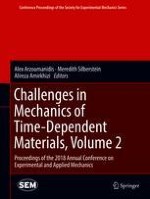
2019 | OriginalPaper | Chapter
1. Modified Hyper-Viscoelastic Constitutive Model for Elastomeric Materials
Authors : Karen Harban, Mark Tuttle
Published in: Challenges in Mechanics of Time-Dependent Materials, Volume 2
Publisher: Springer International Publishing
Activate our intelligent search to find suitable subject content or patents.
Select sections of text to find matching patents with Artificial Intelligence. powered by
Select sections of text to find additional relevant content using AI-assisted search. powered by